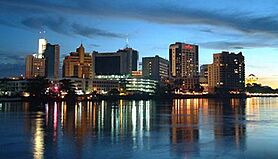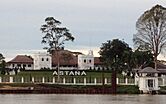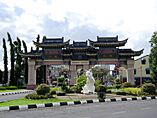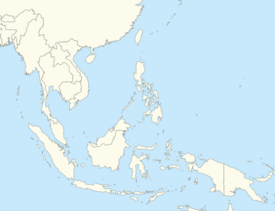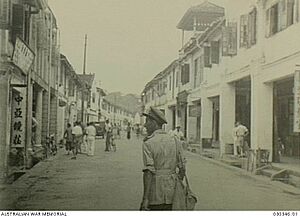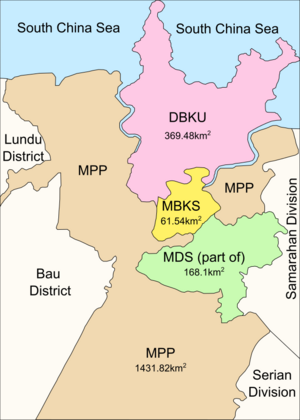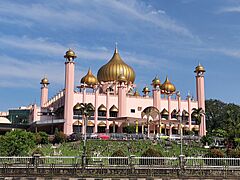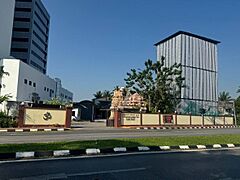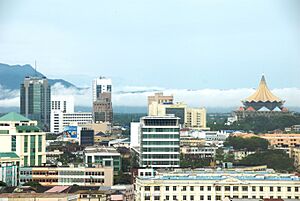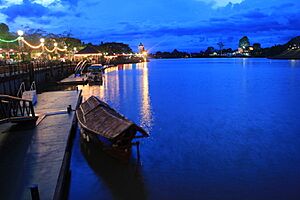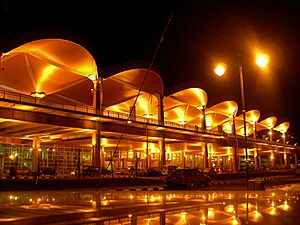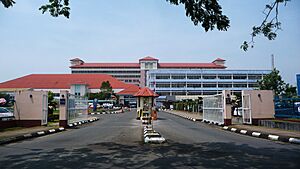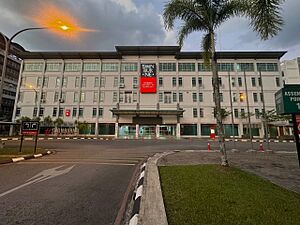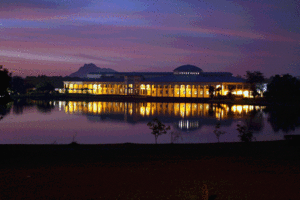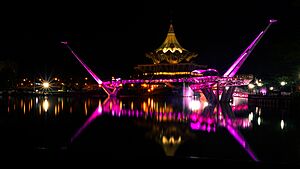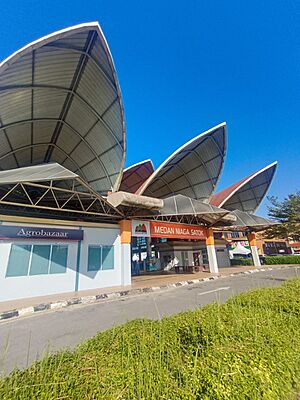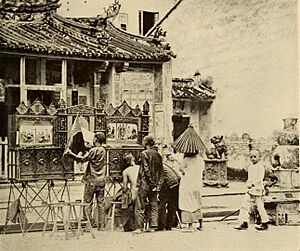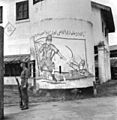Kuching facts for kids
Quick facts for kids
Kuching
|
|||
|---|---|---|---|
|
State capital city and district capital
|
|||
| City of Kuching Bandar Raya Kuching |
|||
| Other transcription(s) | |||
| • Jawi | کوچيڠ | ||
| • Chinese | 古晋 (Simplified) 古晉 (Traditional) Gǔjìn (Hanyu Pinyin) |
||
| • Tamil | கூச்சிங் Kūcciṅ (Transliteration) |
||
|
From top, left to right:
Kuching skyline from Sarawak River, the Sarawak State Museum, Fort Margherita, The Astana, the Darul Hana bridge near State Assembly building, Chinatown, and iconic cat statues. |
|||
|
|||
| Nickname(s):
"Cat City",
Bandaraya Perpaduan (City of Unity) |
|||
| Country | |||
| State | |||
| Division | Kuching | ||
| District | Kuching | ||
| Founded by the Sultanate of Brunei | 1827 | ||
| Settled by James Brooke | 18 August 1842 | ||
| Municipality status | 1 January 1953 | ||
| City status | 1 August 1988 | ||
| Government | |||
| • Type | City council | ||
| • Body | Commission of Kuching North City Hall Council of the City of Kuching South |
||
| Area | |||
| • City of Kuching | 450.02 km2 (173.75 sq mi) | ||
| • Metro | 2,770.90 km2 (1,069.85 sq mi) | ||
| • Kuching North | 378.20 km2 (146.02 sq mi) | ||
| • Kuching South | 71.82 km2 (27.73 sq mi) | ||
| Elevation | 8 m (26 ft) | ||
| Highest elevation | 810.2 m (2,658.1 ft) | ||
| Lowest elevation | 0 m (0 ft) | ||
| Population
(2021)
|
|||
| • City of Kuching | 402,738 | ||
| • Density | 754.33/km2 (1,953.7/sq mi) | ||
| • Metro | 723,854 | ||
| • Metro density | 336.8/km2 (872/sq mi) | ||
| • Demonym | Kuchingite / Orang Kuching | ||
| (Sourced from Department of Statistics Malaysia (DoSM), 2022) | |||
| Time zone | UTC+8 (MST) | ||
| • Summer (DST) | UTC+8 (Not observed) | ||
| Postal code |
93xxx
|
||
| Area code(s) | 082 (landline only) | ||
| Vehicle registration | QA and QK (for all vehicles except taxis) HQ (for taxis only) |
||
| Website | Kuching North: Kuching South: |
||
Kuching (/ˈkuːtʃɪŋ/ KOO-ching), officially called the City of Kuching, is the capital city of Sarawak in Malaysia. It is the biggest city in Sarawak. Kuching is located on the Sarawak River on the island of Borneo. The city covers an area of about 431 square kilometers. It has a population of around 325,132 people.
Kuching became the capital of Sarawak in 1827 under the Bruneian Empire. In 1841, it became the capital of the Kingdom of Sarawak. This happened after James Brooke helped the Bruneian empire. He helped them stop a rebellion. The city grew a lot under the rule of Charles Brooke. New things like a sanitation system, hospital, and fort were built.
During World War II, Japanese forces took over Kuching from 1942 to 1945. After the war, the city was still in good shape. In 1946, Sarawak became a British Crown Colony. Kuching stayed as the capital. When Malaysia was formed in 1963, Kuching kept its capital status. It became a city in 1988. Today, Kuching is managed by two separate local governments. The main government offices for Sarawak are in Kuching.
Kuching is famous for its food and is part of UNESCO's Creative Cities Network. It is also the main entry point for people visiting Sarawak and Borneo. You can find many interesting places here. These include Kuching Wetlands National Park, Bako National Park, and the Sarawak State Museum. Kuching is also an important business and industry center in East Malaysia.
Contents
What Does the Name Kuching Mean?
The name "Kuching" was used even before James Brooke arrived in 1839. There are a few ideas about where the name came from.
The "Cat City" Theory
One idea is that it comes from the Malay word for cat, "kucing". However, local Malays often use "pusak" for cats. Even so, people in Sarawak have made the cat a symbol of their city. You can see cat statues and cat symbols everywhere.
Other Ideas for the Name
Some people think the name came from "Cochin". This was an Indian trading port. Others say the city was first called "Sarawak" before Brooke arrived. It was renamed "Kuching" in 1872 by Charles Brooke.
Another theory is that it came from a fruit called "mata kucing". This fruit grows a lot in Malaysia. There was even a hill in the city named after this fruit. Some old writings say the name came from a stream called "Sungai Kuching" (Cat River). This stream was later filled in to build roads.
There is also a Chinese theory. "Ku" (古) means old and "Ching" (井) means well. So, "Kuching" could mean "old well". An old well in China Street helped people get clean water during a sickness in 1888.
A Brief History of Kuching
Kuching has a long and interesting past. It has been an important place for a very long time.
Early Days and the Brunei Empire
Sarawak was once part of the Bruneian Empire. Kuching became the third capital of Sarawak in 1827. It was founded by a representative of the Sultan of Brunei. Before Kuching, the capitals were Santubong and Lidah Tanah. Kuching grew because antimony ore was found nearby. This ore was in high demand.
The White Rajahs Era
In 1840, James Brooke, a British adventurer, helped the Bruneian ruler stop a rebellion. As a reward, he was given control of Sarawak. On 24 September 1841, Brooke became the Governor of Sarawak, known as the Rajah. Kuching then became the center of the Brooke government.
His nephew, Charles Brooke, continued to develop the city. By 1874, many new buildings were completed. These included a hospital, a prison, and Fort Margherita. Charles Brooke's wife, Margaret Brooke, described Kuching as a "neat and fresh and prosperous" town. She noted the Chinese traders and Indian shops selling goods from all over the world.
The Astana (Palace) was built in 1869 as a wedding gift for Charles Brooke's wife. It is now the official home of Sarawak's governor. Kuching continued to thrive under Charles Vyner Brooke, the third Rajah. In 1941, the Brooke government celebrated its 100th year in Kuching.
World War II and British Rule
During World War II, Japanese forces took over Kuching on 24 December 1941. They ruled for almost four years. A camp called Batu Lintang camp was set up near Kuching for prisoners of war. After the war, the city was still intact.
In 1946, the last Rajah, Sir Charles Vyner Brooke, gave Sarawak to the British Crown. Kuching remained the capital. The British government worked to improve the city's buildings and services.
Becoming Part of Malaysia
When Malaysia was formed in 1963, Kuching kept its status as the state capital. On 1 August 1988, it was officially granted "city status". Since then, Kuching has continued to grow. In 2015, it was named "City of Unity" because of the harmony among its different races.
How Kuching is Governed
As the capital of Sarawak, Kuching is very important for the state's government and economy. Most government offices are located here. The Sarawak State Legislative Assembly building is in Petra Jaya, a suburb of Kuching.
City Administration
Kuching is unique because it is managed by two mayors. The city is split into Kuching North and Kuching South. Each part has its own local authority. Kuching North is managed by a commissioner, and Kuching South by a mayor. The city officially became a city on 1 August 1988.
The city is part of the Kuching District. This district covers 1,868.83 square kilometers. It is the most populated district in Sarawak. The district is divided into two sub-districts: Kuching Proper and Padawan. The areas managed by Kuching North City Hall, Kuching South City Council, Padawan Municipal Council, and Kota Samarahan Municipal Council are together known as Greater Kuching.
Geography and Climate
Kuching is located on the banks of the Sarawak River. This is in the northwestern part of Borneo.
City Limits and Landscape
The city covers about 431 square kilometers. It stretches from Gunung Lasak (Mount Lasak) to Batu Buaya (Crocodile Rock). The Sarawak River generally divides the city into North and South. The highest point nearby is Mount Santubong, which is 810.2 meters above sea level. It is about 35 km north of the city center.
Weather in Kuching
Kuching has a tropical rainforest climate. This means it is moderately hot and very humid. It gets a lot of rain, about 4200 mm each year. Kuching is one of the wettest places in Malaysia, with rain on about 247 days a year. The wettest months are from November to February. The driest months are June to August. Temperatures usually range from 23°C in the morning to 33°C in the afternoon.
People and Languages
People from Kuching are sometimes called "Kuchingite" or "orang Kuching" (people of Kuching).
Who Lives in Kuching?
| Ethnic composition in Kuching (2022) | ||||
|---|---|---|---|---|
| Ethnic group | Percent | |||
| Malay | 36.2% | |||
| Chinese | 34.1% | |||
| Iban | 20.5% | |||
| Bidayuh | 4.9% | |||
| Others | 3.6% | |||
In early 2022, Kuching had a population of 402,738 people. The main ethnic groups are Malays, Chinese, Iban, and Bidayuh. There are also smaller groups like Melanau and Indian people.
The Chinese community includes groups like Hokkien, Foochow, and Hakka. Many different cultures live together in Kuching. It is common for people from different backgrounds to marry here. The city is home to over 30 different ethnic groups.
- Religious sites in Kuching
What Languages Are Spoken?
The local Malay dialect spoken in Kuching is called Bahasa Sarawak or Sarawakian Malay. It is a bit different from Malay spoken in other parts of Malaysia. Since many Chinese people live here, Chinese is also commonly spoken, especially Hokkien and Mandarin. Almost everyone in Kuching can speak English.
Economy and Business
Kuching is a major center for industry and business in Sarawak. Many banks and insurance companies have their main offices here. The economy is mostly based on services and primary industries. The state government wants Sarawak to become more developed by 2020.
Key Industries
There are three main industrial areas in Kuching. These are Pending Industrial Estate, Demak Laut Industrial Park, and Sama Jaya Free Industrial Zone. These areas help boost business and industry in the city. Kuching also hosts many national and international conferences and trade fairs. Events like the Rainforest World Music Festival are held here.
The Kuching Port Authority (KPA) manages the city's ports. These ports handle millions of tonnes of goods each year. Historically, the Chinese community has played a big role in Kuching's economy. They helped develop industries like antimony mining and pepper farming.
Getting Around Kuching
Kuching has a good transport system for getting around the city and to other places.
Road Transport
The roads in Kuching are managed by local councils or the Public Works Department. Most major roads have two lanes in each direction. Kuching is connected to other towns in Sarawak by federal roads. The city is known for its many roundabouts, which help manage traffic. However, traffic lights are now used more often as the city grows.
Public Transport Options
Taxis
You can find two types of taxis in Kuching. The standard taxis are red and yellow. There are also larger blue taxis, which are more comfortable but cost a bit more. You can also book taxis using a smartphone app called GrabTaxi.
Buses
Kuching has both local and express bus services. The main bus terminal is Kuching Sentral, which opened in 2012. It is located near the Kuching International Airport. From here, you can take long-distance buses to places like Brunei, Sabah, and West Kalimantan, Indonesia. There are also local buses that connect different parts of the city.
Water Transport
Water transport is also common in Kuching. Traditional wooden boats called 'tambang' carry passengers across the Sarawak River in the city center. For longer trips to places like Sibu and Bintulu, you can take express boats from the Sim Kheng Hong Port.
Air Travel
The Kuching International Airport (KCH) is the main airport for air travelers. It is the fourth busiest airport in Malaysia. The airport has grown a lot since 2009. It is a hub for Malaysia Airlines and AirAsia. It also serves flights to smaller towns in East Malaysia through MASWings.
Important Services in Kuching
Kuching provides many important services for its residents.
Courts and Law Enforcement
The main court complex is in Petra Jaya. It includes the High Court, Sessions Court, and Magistrate Court. There are also Syariah Courts and native courts. The police headquarters for Sarawak is in Badruddin Street. The Kuching Prison Complex is located in Puncak Borneo Street.
Healthcare Services
The city has many health services. The main public hospital is the Sarawak General Hospital, which opened in 1923. There is also the Rajah Charles Brooke Memorial Hospital and Hospital Sentosa, which provides mental health services.
Several large private hospitals are also in Kuching. These include Normah Medical Specialist Centre, Borneo Medical Centre, and Timberland Medical Centre.
Education Opportunities
Schools in Kuching are managed by the Kuching Combined Education Office. There are schools for pre-school, primary, secondary, and post-secondary levels. Some well-known government secondary schools include SMK St. Joseph and SMK St. Thomas. Kuching also has four Chinese independent schools. There are three international schools: Tunku Putra International School, Lodge International School, and Borneo International School.
For higher education, Kuching has three private universities: the Swinburne University of Technology Sarawak Campus, Executive College, and UCSI University, Sarawak Campus. There is also a polytechnic and a community college. Many other private colleges offer various courses.
Libraries for Learning
The Sarawak State Library is the main place for information and public records. It helps manage 36 village libraries across the state. Other public libraries in Kuching include the DBKU City Library.
Fun Things to Do in Kuching
Kuching offers many attractions, from cultural sites to shopping and entertainment.
Exploring Culture and History
Museums to Visit
Kuching has several museums that show its rich culture and history. The Sarawak State Museum is one of the best museums in Asia. It displays collections from Sarawak's native groups. The new Borneo Cultures Museum is a modern building that shows Sarawak's traditional crafts. The Islamic Heritage Museum is also nearby.
Other museums include the Chinese History Museum, Kuching Cat Museum, and Sarawak Timber Museum. Kuching also has Malaysia's first planetarium, the Planetarium Sultan Iskandar.
Historical Places to See
Important historical sites include The Astana, which was the palace of the White Rajahs. It is now the official residence of the governor. Fort Margherita is another historical landmark.
The Main Bazaar is Kuching's oldest street. It has 19th-century Chinese shops along the Kuching Waterfront. This area is great for finding antiques and handicrafts. The old Courthouse building now houses the Sarawak Tourism Board. Padungan Street is Kuching's Chinatown.
Nature and Outdoor Activities
Parks and Conservation Areas
The Talang-Satang National Park helps protect Sarawak's marine turtles. It includes four "Turtle Islands" where 95% of all turtle landings happen. The park also has areas for bird watching.
Damai is a main beach resort area on the Santubong Peninsula. It has sandy beaches and jungle-covered mountains. You can find resorts, an 18-hole golf course, and activities like jet-skiing. You might even spot Irrawaddy dolphins here.
National parks near Kuching include Bako National Park and Kuching Wetlands National Park. The Semenggoh Wildlife Centre helps rehabilitate orangutans. Other beaches near Kuching are Lundu Beach and Sematan Beach.
Shopping and Entertainment
Shopping Malls and Markets
Kuching has many shopping malls. Some popular ones are VivaCity Megamall, Aeon Mall Kuching Central, and The Spring. The Satok Weekend Market is open on Saturdays and Sundays. You can find fresh vegetables, fruits, handicrafts, and local snacks there.
Cinemas and Festivals
There are five cinemas in Kuching, mostly inside shopping malls. The city also hosts the Bookaroo, a children's literature festival, every April.
Music and Radio
Since 1997, Kuching has hosted the Rainforest World Music Festival (RWMF). This annual music festival brings performers and visitors from all over the world. It is one of the biggest music events in Malaysia.
You can listen to many radio stations in Kuching, including Radio Klasik FM, Sarawak FM, Cats FM, and Hitz.
International Connections
Several countries have consulates in Kuching. These include Australia, Brunei, China, Indonesia, and the United Kingdom.
Sister Cities Around the World
Kuching has special partnerships with twelve other cities around the world. These are called "sister cities". They include:
- Dali, China
- Kunming, China
- Xiamen, China
- Zhenjiang, China
- Bandung, Indonesia
- Pontianak, Indonesia
- Singkawang, Indonesia
- Johor Bahru, Malaysia
- Jeddah, Saudi Arabia
- Nashville, USA
- Ottawa, Canada
- Guro, South Korea
Images for kids
-
Children are pulled through the city's streets by a coolie, around 1919.
See also
 In Spanish: Kuching para niños
In Spanish: Kuching para niños


